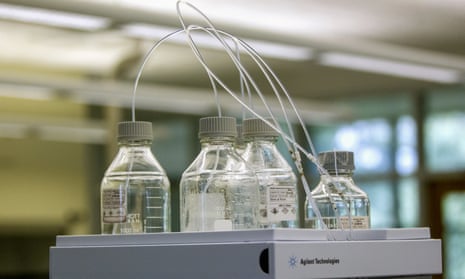The US Environmental Protection Agency has taken the extraordinary step of setting proposed legal drinking water limits for six of the most studied and toxic PFAS compounds, known commonly as “forever chemicals”, that are at the center of an ongoing environmental crisis.
The new limits mark the first time in 26 years that the EPA has set legal limits for a contaminant in drinking water. Municipal utilities will be required to remove the compounds from drinking water, which could set off a wave of lawsuits directed at PFAS polluters, including the US military and chemical producers like 3M, DuPont and Chemours.
The new rules are “groundbreaking”, said Erik Olson, senior strategic director for the Natural Resources Defense Council non-profit, which tracks PFAS pollution.
“We have a five-alarm fire, and setting strong standards will help ensure the fundamental right of every family to have safe water flowing from their kitchen tap,” he said.
PFAS, or per- and polyfluoroalkyl substances, are a class of about 14,000 chemicals often used to make products resist water, stains and heat. They are called “forever chemicals” because they do not naturally break down, and are linked to cancer, liver problems, thyroid issues, birth defects, kidney disease, decreased immunity and other serious health problems.
By some estimates, PFAS are contaminating drinking water for more than 200 million Americans, and the EPA has said it has moved more quickly to regulate the compounds than any in the agency’s history.
Between 2016 and 2022, the agency worked off an advisory health limit of 70 parts per trillion (ppt) for PFOS and PFOA, two compounds commonly produced and used for decades. Last year, after science showed virtually no level of exposure to drinking water is safe, the EPA set non-enforceable “advisory health limits” of 0.02 ppt and 0.004 ppt for PFOA and PFOS, respectively.
The new legal limits for PFOS and PFOA is 4 ppt each, levels that science shows are still dangerous to drink. Public health advocates say the discrepancy is likely the result of industry pressure on the EPA and an inability of PFAS tests that regulators use to check water for the chemicals at levels as low as 0.02 ppt.
Though chemical manufacturers say they voluntarily phased out production of PFOS and PFOA about a decade ago, the compounds persist in large quantities in the environment and Americans’ blood because they take decades to degrade.
“Is 4 ppt where we would like to be? Absolutely not, and that’s why the EPA has much lower health advisories,” said Linda Birnbaum, a former head of the US National Toxicology Program and EPA scientist. “But it is a heck of a lot better than the previous advisory of 70 ppt.”
As industry phased out the chemicals, it introduced a new generation of PFAS it claimed were safe alternatives, including GenX and PFBS. However, an ever-growing body of scientific evidence has found those to be nearly as toxic as the first generation.
The EPA set a variable “health hazard index” that includes PFBS, GenX, PFHxS and PFNA. The approach requires the chemicals to be removed from water when one or more in the combination pose a health risk.
Though public health advocates largely praised the limits, they note that it addresses only six out of about 14,000 PFAS compounds, and they called on the EPA to regulate the entire chemical class. The state of Maine and the European Union are moving to regulate the chemicals as a class. Federal class regulation “cannot come soon enough”, said David Andrews, a senior scientist with the Environmental Working Group non-profit.
“These six PFAS stand out as some of the most well-studied PFAS, but the entire class of chemicals are a health concern,” he said.
This article was amended on 9 April 2024 to clarify that the EPA was setting proposed legal drinking water limits for six of the most studied and toxic PFAS compounds. A previous version did not indicate they were proposals.
